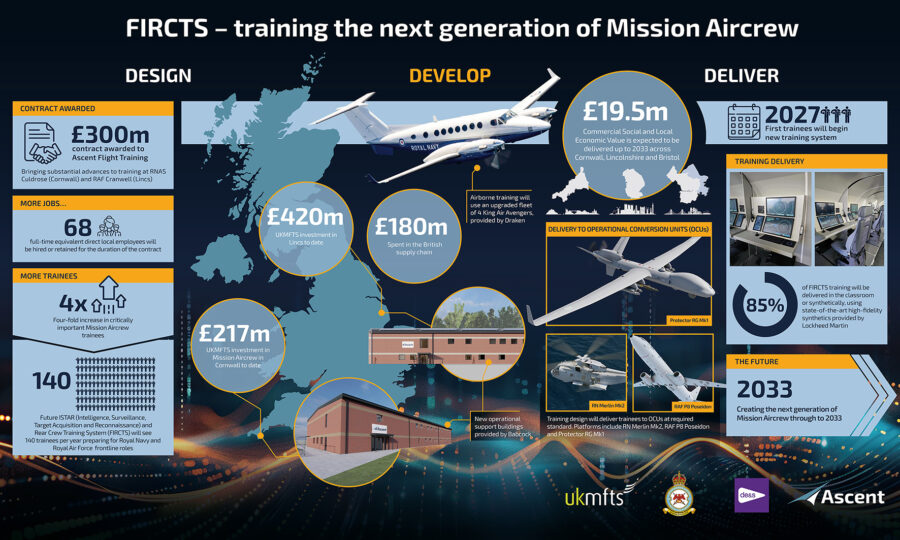
A £300m defence contract awarded to Ascent Flight Training will mean substantial advances to training at Royal Naval Air Station (RNAS) Culdrose and Royal Air Force (RAF) Cranwell – enhancing the UK’s key defence capabilities and investing in local communities.
The award of the Future ISTAR (Intelligence, Surveillance, Target Acquisition and Reconnaissance) and Rear Crew Training System (FIRCTS) programme is part of a continuing investment by Ascent in local economies in Cornwall, Lincolnshire and Bristol.
The massive scaling of this service will result in a four-fold increase in critically important mission aircrew trainees to 140 per year for the Royal Navy and RAF. FIRCTS will deliver the latest training advances through the UK’s Military Flying Training System (UKMFTS) to meet growing ISTAR and UAS demands of the military frontline.
To date, Ascent’s investments in Rear Crew Training in Cornwall have totalled £217m, with an additional £420m invested in Elementary Flying Training and Multi-Engine Pilot Training in Lincs.
FIRCTS will recapitalise RNAS Culdrose in Cornwall and RAF Cranwell in Lincs, with new operational support buildings provided by Babcock International. Bespoke courseware development will be provided by a dedicated team at Ascent’s Bristol headquarters.
Lockheed Martin will provide state-of-the-art high-fidelity synthetic environments and mission simulators, to significantly enhance ground based training, while Draken will provide support for the fleet of upgraded Textron King Air 350E Avenger aircraft.
FIRCTS is also expected to deliver a combined c£19.5m Commercial Social and Local Economic Value across Cornwall, Lincs and Bristol up to 2033. Around 68 full-time equivalent direct local employees will be hired or retained for the duration of the contract and £180m spent in the British supply chain.
Building on success
Ascent, in its role as prime contractor for UKMFTS, continues to build on its success with previous UK MOD contracts and to work closely with key suppliers Lockheed Martin, Babcock International and Draken.
It has delivered RCS1 at RNAS Culdrose since April 2011, including a Basic Flying Training course for Royal Navy Observers (RNO) and RAF Weapon Systems Officers (WSO), initially training up to 36 trainees each year.
Minister for Defence Procurement and Industry, Rt Hon Maria Eagle MP said: “This significant investment represents important progress in preparing our Royal Navy and Royal Air Force personnel for the challenges of modern warfare. Not only will this state-of-the-art training capability ensure our Armed Forces remain at the forefront of military readiness, but it also delivers on our Plan for Change by creating high-quality jobs and strengthening local economies.”
Ascent MD, Tim James said: “We are so proud to once again be trusted by our UK MOD customers to deliver this innovative training solution across our operations sites in Cornwall and Lincolnshire, directly benefiting our local communities and delivering a critical capability for the UK Armed Forces.”
Captain Polly Hatchard, UKMFTS Team Leader, said: “The Future ISTAR and Rear Crew Training System is a capability which will ensure the UK is at the forefront of providing world-class air power operational capability. Today’s air systems require aircrew who can exploit the electro-magnetic spectrum and assist in decision-making as we seek to out-pace our adversaries in complex battlespace. FIRCTS reflects another training transformation within UKMFTS and has been enabled by superb collaboration between the frontline commands, DE&S and industry.”
Air Commodore Rob Caine, Head of Flying Training, said: “The introduction of the Future ISTAR and Rear Crew Training System will ensure that we can safely deliver world-class personnel to the front-line to operate in vital roles on our latest aircraft platforms including Poseidon, Rivet Joint and Wedgetail. The investment in the latest training technology and infrastructure at RNAS Culdrose and RAF Cranwell will help us to prepare aircrew to be ready to Fly, Fight and Win in an uncertain world.”
Emlyn Taylor, Group Managing Director of Lockheed Martin UK, Rotary and Mission Systems, said: “The Lockheed Martin FIRCTS solution provides an impressive Rear Crew and UAS training capability, but this is just the foundation. Through spiral development, this solution will evolve to meet operational demands of the future, ensuring a high-quality, cost-effective solution!”
Chloe Barker, Managing Director for Babcock’s UK Aviation business, said: “Ascent’s role in delivering military flying training ensures the UK’s armed forces are equipped with the skills they need for the demands of today’s modern operating environments. We’re proud to be supporting the FIRCTS programme by delivering key infrastructure that will be used to help deliver next generation training for aircrew.”
Simon Tate, UK Managing Director for Draken, said: “This new service will be used to train rear crew across the armed services to navigate and integrate into networks, enabling control of advanced weapons on multiple platforms. We have been providing critical support to the Rear Crew Training delivered to all three UK armed forces for more than 20 years and now, thanks to this investment, we can continue to celebrate our partnerships with the installation and delivery of a new Airborne Mission Trainer.”

Blend of training methods
The FIRCTS training system – boosted by Ascent’s embedded subject matter experts – will use a blend of e-learning, high fidelity, fully immersive synthetics and live airborne training events, to maximise learning outcomes and knowledge retention.
Around 85% of FIRCTS training will be delivered in the classroom or synthetically, using a new state-of-the-art mission simulator. This enables a more cost-effective, digitised training system that keeps pace with the rapidly evolving landscape of modern warfare and enables our teams to sustainably reduce both flying hours and our carbon footprint.
All airborne training will use the upgraded fleet of four King Air Avengers. Modifications to the aircraft will accommodate increased training capacity and the onboard mission computer will use the same software as the ground based mission simulator, enabling a seamless transition for trainees.
The system will ensure that newly skilled operators are delivered to Operational Conversion Units, ready to engage with emerging technologies and the latest platforms, including the Merlin Mk2 and Wildcat helicopters, RAF Poseidon MRA1, Rivet Joint, and remotely piloted air systems such as the Protector RG Mk1.
The first trainees will be able to use the new training system in 2027.



